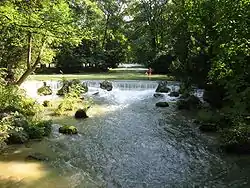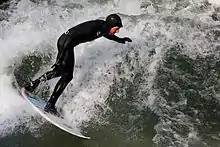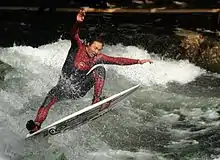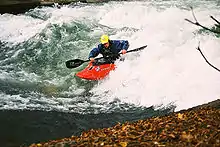Eisbach (Isar)
The Eisbach (German for "ice brook") is a small, 2-kilometre-long (1.2 mi), man-made river in Munich. It flows through the park known as the Englischer Garten, and is a side arm of the Isar River. A man-made wave has been created on one section, which is popular among river surfers.
| Eisbach | |
|---|---|
 Small waterfall of the Eisbach | |
| Location | |
| Country | Germany |
| State | Bavaria |
| Physical characteristics | |
| Length | 2 km (1.2 mi) |
Swimming in the Eisbach is not technically allowed,[1] but as the rule is not stringently enforced, swimmers can be seen especially on warm summer days. However, swimming in the cold and fast river is dangerous: Between 2007 and 2017 alone, eight people drowned in the Eisbach.[2][3][4][5][6]
Surfing on the Eisbach



Just past a bridge near the Haus der Kunst art museum, the river forms a standing wave about one metre high which is a popular river surfing spot. The water is cold and shallow—sometimes only 40 cm deep—making it suitable only for experienced surfers and playboaters (whitewater kayakers). The wave is predominantly used by surfers, and animosities of surfers towards kayakers have occasionally been reported.[7]
The wave has been surfed by river surfers since 1972, and surfing competitions have even been held. Due to the more recent development of playboating, kayakers have only more recently—and so far not in great numbers—started to surf the wave.
Since 2010 surfing has been officially permitted on the river.[8] A new sign next to the wave warns that "Due to the forceful current, the wave is suitable for skilled and experienced surfers only." In previous years there has been an issue between the authorities, who threatened to demolish the wave, and a group of wave supporters who organized activities and a website to save the wave, including an online petition to leave the wave intact.[9]
Being a standing wave, it can be surfed for as long as one's balance holds, and in busy times a queue of surfers forms on the bank. In the past surfers tied a leash to the bridge to hold onto, but a sign announces that this is both dangerous and forbidden.
The local surfers have forced the wave to break more cleanly, with increased height, by attaching ropes to the bridge which trail submerged planks, creating two large "U"-shapes. Such a shape makes the wave easier to surf for river surfers (playboating makes fewer demands of the wave shape).
There is a second standing wave on the Eisbach located a few hundred meters downstream further north in the Englischer Garten. The Eisbach is wider at this point, so the water flows more slowly and the wave is less demanding, which results in the wave being used by beginners to develop their surfing skills. Another wave for beginners is in Floßlände near the Thalkirchen U-Bahn station. It has also been surfed since 1972, and it is wide enough to take a few surfers at a time. A third standing wave in Munich forms on the Isar itself near the bridge Wittelsbacherbrücke, but only at flood levels of the river. Due to the dirt, manure, and objects such as tree branches drifting in the floodwater in the first days after flooding, this wave is usually surfed only a few days after the water level has risen.[10]
Swimming in the Eisbach
Although authorities don't strictly enforce the swimming ban, they caution against the dangers even for experienced swimmers: The Eisbach has a very strong current and no affixed exit points, which makes it hard to get out again. Hence, swimmers sometimes float too far and get stuck in the lattice behind the Tivoli bridge before the hydroelectric power plant, where they must be rescued. Also, the Eisbach is shallow, which can lead to injuries not only when jumping in, but while swimming as well, also because obstacles like stones, broken glass and even disposed bicycles can be found on the ground. Lastly, even in the summer, the water doesn't get warmer than 15 °C, which harbors the risk of hypothermia.[11]
See also
References
- http://www.abendzeitung-muenchen.de/inhalt.nach-tod-einer-15-jaehrigen-baden-verboten-im-eisbach-das-sind-die-gruende.d0f1f843-5705-4bde-be66-54676c07f79f.html
- TV Bayern Media (2017-05-31). "München: 15-jähriges Mädchen stirbt im Eisbach". Retrieved 2017-06-01.
- http://www.n-tv.de/panorama/Schon-wieder-ein-Toter-im-Eisbach-article19885462.html
- (quote by the Referat für Umwelt und Gesundheit, an agency for environment and health) (retrieved on 15 September 2008)
- http://www.wochenanzeiger.de/article/69945.html
- Susi Wimmer (22 March, 2007). Grausige Entdeckung. Vermisster Doktorand im Eisbach ertrunken. Archived 2008-09-15 at the Wayback Machine Süddeutsche Zeitung (retrieved on 15 September 2008)
- e.g., 22.02.2008 - jup - Surf-Etiquette an der Eisbach-Welle in München (German)
Surfing the Eisbach Archived 2006-01-28 at the Wayback Machine - "Munich". Somewhere Street. Japan. NHK World. Retrieved September 1, 2016.
- online petition on www.rettet-die-eisbachwelle.de Archived 2008-09-15 at the Wayback Machine
- Isar River Surf. die Eisbach Wellenreiter am Haus der Kunst (retrieved on 15 September 2008)
- https://www.sueddeutsche.de/muenchen/englischer-garten-warum-immer-wieder-menschen-im-eisbach-ertrinken-1.3529274
Further reading
External links
 Media related to Eisbach (Munich) at Wikimedia Commons
Media related to Eisbach (Munich) at Wikimedia Commons